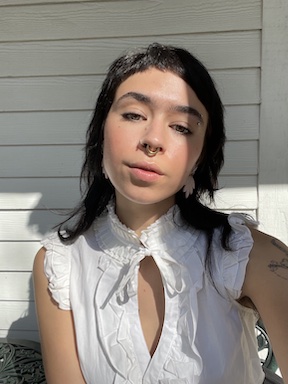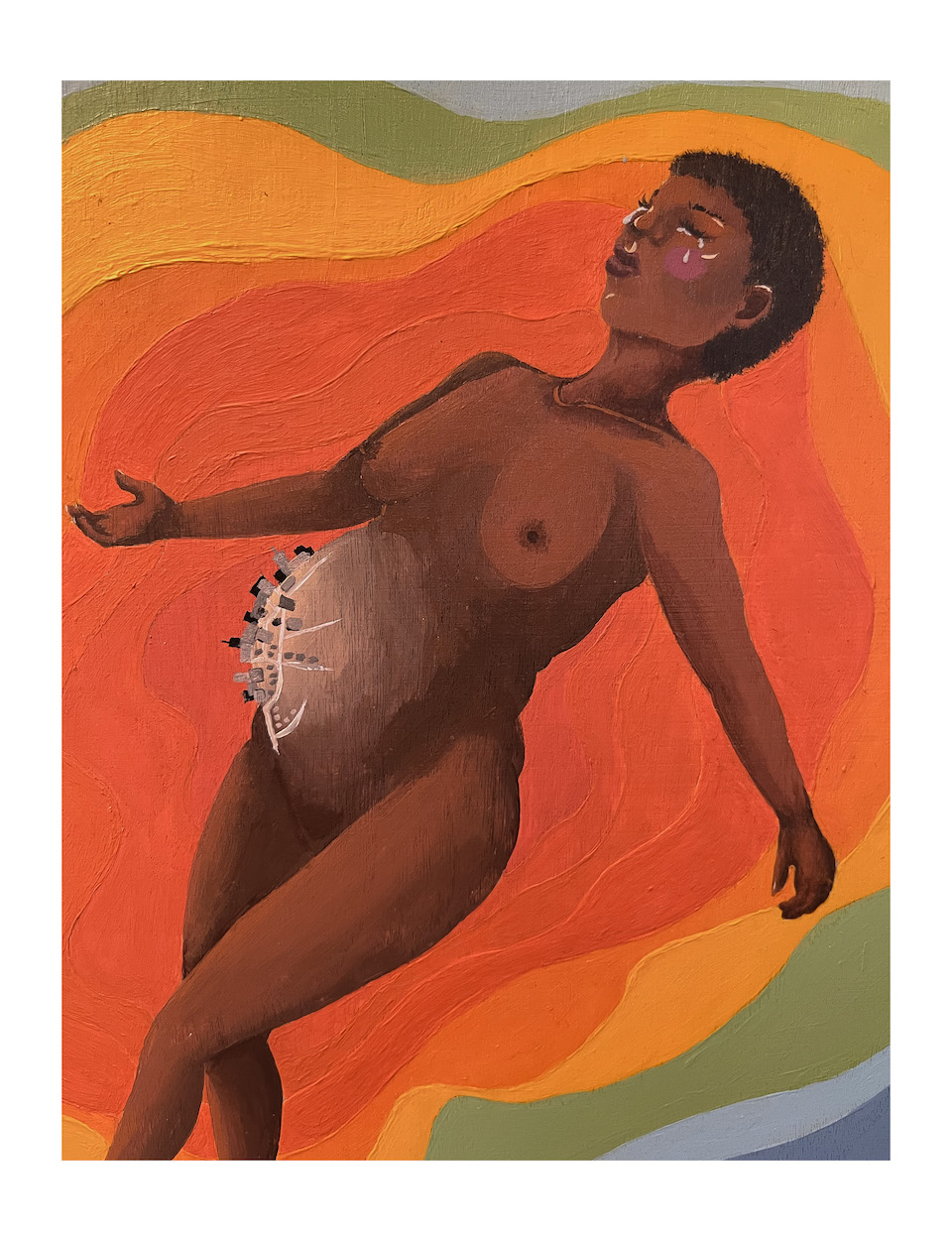Esther Winterman

I am a third year student at Indiana University studying bioanthropology. Living my entire life in Bloomington, Indiana, my small town community is very important to me. So many of our class discussions struck me so deeply, because the importance of community care is at the root of so many of the issues we discussed. I have been a hobby artist my whole life, dabbling in fashion design, quilting and fiber arts, and painting.
What does water mean to me? To me, water represents life, beauty, safety, and security. I view water as the root of life: organisms are made from it, and we need it for our survival. Water can be a source of beauty in nature, and a symbol of civilization for humans and other mammals. After taking this class, I find myself having a much more emotional perspective on water. I am very lucky to have stable access to clean water, and that is something I can never take for granted.
For my part in this class project, I decided to do a painting titled “Mother”. I find that the best way for me to express myself and my thoughts are through art, and I was very much inspired by the material from our class. "Mother" was created using acrylic paint on a wooden canvas, taking around 15 hours (including sketching, mixing colors, and painting) to make. Once the painting was completed, I photographed my work and digitally edited some of the colors and tones so that it could be properly viewed online. This painting is intended for all audiences, and I hope that anyone viewing it can take away either my intended message, or something of their own.
Much of this work was inspired by the film "Pumzi", 2009. My specific visual inspirations from the film are discussed throughout this page, but my multiple viewings of the short film were the catalyst in creating this painting. One of my biggest takeaways from the film was the question, "What sacrifices are you willing to make for the protection of your community?"
"Mother", 2022.

My painting depicts a pregnant feminine figure, sprawled out over a background of wavy stripes that transition from red and orange to blue. The figure is imagined to be Mother Earth; her stomach is home to a city, but her skin around it has lost its life and pigmentation. This is representative of the damage infrastructure and human settlement has done to the planet’s water supply. The rest of her body that is free of settlement appears healthy, but I have chosen to depict her crying. She has given her own life and body to foster life for others, but the life she has given is depleting her resources; just as the planet Earth has given us life, but the decisions humankind has made has depleted Earth’s resources beyond repair.
The background was inspired by color-coded water scarcity maps[1], and one in particular that identified locations with the highest water scarcity with shades of red and orange, lower levels of water scarcity with yellow, and any large bodies of water with blue. I chose to emulate this in my painting by focusing the deepest shades of orange and red around the figure’s abdomen, with each organic stripe transitioning in hue from orange, to yellow, to green, to blue. The focus of the orange and red shades around the abdomen is further emphasis on the damage the city is doing to Mother Earth’s water supply. The only part of her body touching a blue area are her toes, showing that a stable access to water is so close yet so far.
For the painting as a whole, I was inspired by the imagery in the short film "Pumzi"[2]. The final shot of the film depicts the main character, Asha, laying herself to rest in the barren desert and giving her life and body to nourish the sprout of a tree. As the frame grows and zooms out, it shows that just beyond Asha’s resting place was a lush, growing forest, signaling an abundance of water. I was deeply inspired by this visual and the juxtaposition between forest and desert. This is represented in both the background and the figure, in the color transition from orange to blue, and in the changes in skin tone of the figure’s body.
My choice to make the figure a pregnant mother was inspired primarily by our class discussions about Flint, Michigan. We read and discussed an article about Flint[3] that inspired an activity in class. We split off into small groups to act out the dynamic for a family experiencing water scarcity. One student played the role of a young child, while the other one or two students played the role(s) of an adult caregiver. The importance of the exercise was to show the difficulties families and parents are facing. What are you supposed to tell your child when they are thirsty but cannot drink the water in their own home? What are you supposed to tell your child when you have no water? Parents in communities facing water scarcity are having to watch their children and families suffer at the hands of governing bodies and the climate crisis. Mothers are often saddled with being the primary caregivers of their children, and that sacrifice can’t go unnoticed especially within communities in crisis. This paired with the concept of “Mother Earth” inspired me to depict a mother; she is powerful, but she is also hurting, and she is mourning the pain of the life she is fostering.
[1] Yantz, “Water Scarcity: A Global Crisis.”
[2] Pumzi, 19:25 to 20:15.
[3] O’Donnell, “The Flint Water Crisis.”

References
Kahiu, Wanuri, director. Pumzi. Focus Features, 2009. 21 min., 50 sec. https://www.youtube.com/watch?v=IlR7l_B86Fc. Accessed 9 Dec. 2022.
O'Donnell, Kelly. “The Flint Water Crisis.” ArcGIS StoryMaps. August 17, 2020. https://storymaps.arcgis.com/stories/2b3c891c17a944e49259811896af70a0.
Yantz, Clifford. “Water Scarcity: A Global Crisis.” Wells For The World. June 18, 2022. https://www.wellsfortheworld.org/water-scarcity-a-global-crisis/.
"Mother" © 2022 by Esther Winterman is licensed under CC BY-NC 4.0

